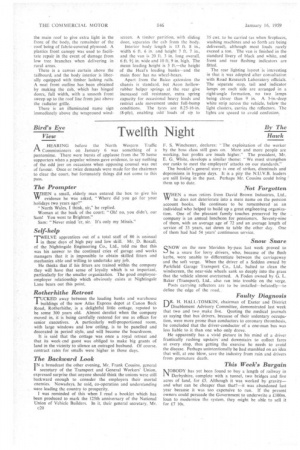Extra Capacity for Furniture
Page 55

Page 56

If you've noticed an error in this article please click here to report it so we can fix it.
THE latest delivery vehicle to be placed in service
with Heal and Son, Ltd., Tottenham Court Road, London, W.1, offers some 200 Cu. ft. greater body capacity than other vans in the fleet, yet its overall dimensions are no larger and several loading and driving advantages are offered. The new van has a total capacity of approximately 740 cu. ft., arid is based on a Commer 30-cwt. forward-control oilengined chassis with a Baico I-ft. 9-in, wheelbase extension, One of the biggest problems confronting operators of furniture-delivery vehicles is bulk, and for this reason 2-ton and 3-tois chassis frequently have to be used merely to obtain the necessary frame length. Most of the existing vehicles in the Heal's fleet are of this type, all but one of them being petrol-engined and based on normal-control chassis.
Whilst greater body capacity was desirable, limitations on overall size were imposed by the size of the loading bays. Forward-control chassis had hitherto been ruled out because of difficult access
to the cab, but by using the Commer 30-cwt. chassis with extended wheelbase it has been possible to give the requisite extra capacity, good access to the cab, a wide arc of forward vision and. because of the 16-in, wheels, a low loading height.
The van, which was supplied by Regal Garage (Old Kent Road), Ltd.. London. S.E.15, has a Glover, Webb and Liver .sidge composite body, and the complete vehicle has a licensing weight of 2 tons 8 cwt.
The main body panels are of metalfaced plywood, but the Luton head, which has a capacity of 80 cu. ft., is of colour-impregnated plastics panels. Plastics is also used for the 2-ft. by 6-ft. 6-in. translucent panel in the forward part of the main roof to give extra light in the front of the body, the remainder of the roof being of fabric-covered plywood. A plastics front canopy was used to facilitate repair in the event of damage from low tree branches when delivering in rural areas.
There is a canvas curtain above the tailboard, and the body interior is liberally equipped with timber lashing rails. A neat front outline has been obtained by making the cab, which has hinged doors, full width, with a smooth front sweep up to the roof line from just above the radiator grille.
There is an illuminated name sign immediately above the wrapround wind screen. A timber partition, with sliding door, separates the cab from the body. Interior body length is 13 ft. 8 in., width 6 ft. 6 in. and height 7 ft. 7 in., and the van is 20 ft. 3 in. long overall, 6 ft. 91 in. wide and 10 ft. 9 in. high. The Mean loading height is 3 ft.—the height of the Heal's loading banks—and the main floor has no wheel-boxes.
Apart from the Baico extension the chassis is standard, but Aeon .hollowrubber helper springs at the rear give increased roll resistance, extra spring capacity for occasional heavy loads and restrict axle movement under full-bump conditions. The tyres are 8.25-16-in. (8-ply), enabling odd r loads of up to
35 cwt. to be carried (as when fireplaces, washing machines and so forth are being delivered), although most loads rarely exceed a ton. The van is finished in the standard livery of black and white, and front and rear flashing indicators are fitted.
The rear lighting layout is interesting in that it was adopted after consultation with Road Research Laboratory officials. The separate stop, tail and indicator lamps on each side are arranged in a right-angle formation, no two lamps being closer than 9 in. A 3-in.-deep. white strip across the vehicle, below the light clusters, carries the reflectors. The lights are spaced to avoid confusion.








































































































